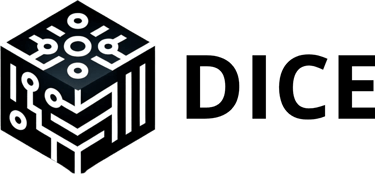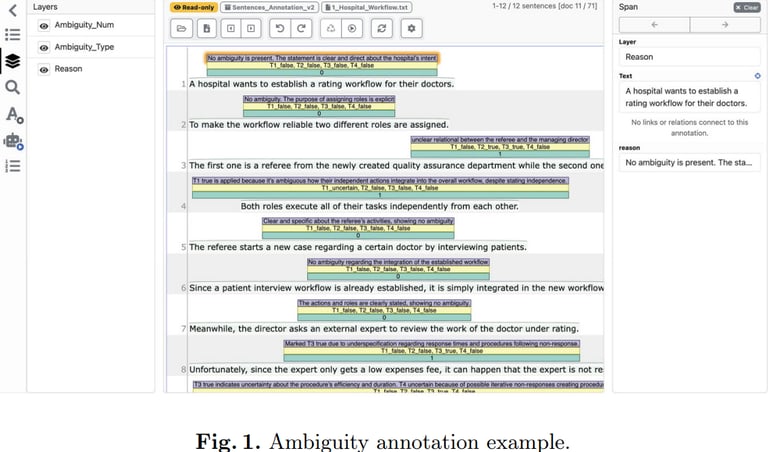

Ambiguity Detection in Business Process Descriptions: An Evidence and an Automated Approach
López, H.A., Feng, B., Lindner, J., Franceschetti, M., Abbad-Andaloussi, A. (2026). Ambiguity Detection in Business Process Descriptions: An Evidence and an Automated Approach. In: Senderovich, A., Cabanillas, C., Vanderfeesten, I., A. Reijers, H. (eds) Business Process Management. BPM 2025. Lecture Notes in Computer Science, vol 16044. Springer, Cham. https://doi.org/10.1007/978-3-032-02867-9_23
Abstract: This paper examines the role of ambiguity in process descriptions and how feasible it is to identify ambiguities using automated techniques. Process descriptions are natural language specifications of a business process. An ambiguity occurs whenever part of the specification can be understood in multiple ways. Ambiguities harm model quality, as well as comprehension and business process execution. This paper provides two contributions. First, it examines the prevalence of ambiguities in process descriptions. Second, it explores how the creation of computational artifacts could support the identification of ambiguities at design time. We constructed a dataset of process descriptions considering multiple authors, writing styles, and possible uses in academia and industry. In a dataset of N=71 process descriptions, we show that ambiguities are a prevalent phenomenon, where 94,3% of the descriptions exhibit at least one type of ambiguity. Concerning identification, we can see that standard classifier techniques fall short in identifying ambiguities. At the same time, the application of pre-trained and fine-tuned LLMs improves the identification of ambiguity significantly. By demonstrating the presence of ambiguities in process descriptions and identifying them, our work aims to influence research on the application of Natural Language Processing (NLP) in Business Process Management (BPM) by refining pipelines to consider multiple interpretations. Moreover, it advocates for the transformative role of NLP as a tool that can promote clearer and more reliable process definitions.
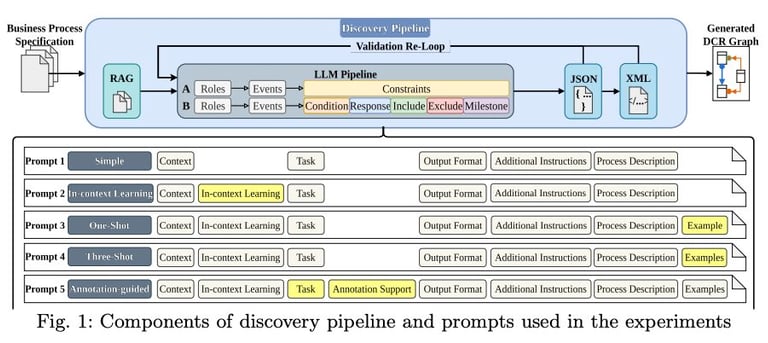

Discovering Declarative Processes in Textual Description using Large Language Models
Lindner, J., & López-Acosta, H.-A. (Accepted/In press). Discovering Declarative Processes in Textual Descriptions using Large Language Models. In Proceedings of The Second International Workshop on Generative AI for Process Mining, GenAI4PM 2025 Springer.
Abstract. This study investigates whether generative AI (GenAI) techniques can enhance the extraction of declarative process models represented as DCR graphs. Declarative process models, unlike imperative ones, capture rules and constraints, making the mapping of their semantics from textual specifications a non-trivial task. Prior research has primarily focused on text mining and pattern-matching techniques to extract individual declarative statements, while the generation of complete specifications remains a more complex challenge. This work examines whether prompt engineering and large language models can improve the accuracy and completeness of this task in comparison to existing methods. The study introduces an LLM-based architecture for extracting declarative process models as DCR graphs, evaluates the extraction results against a manually curated gold standard, and benchmarks the approach against earlier extraction pipelines. Preliminary results indicate that LLM-based pipelines show promising performance in identifying events and roles; however, constraint mining still requires more precise methods before it can be reliably automated.

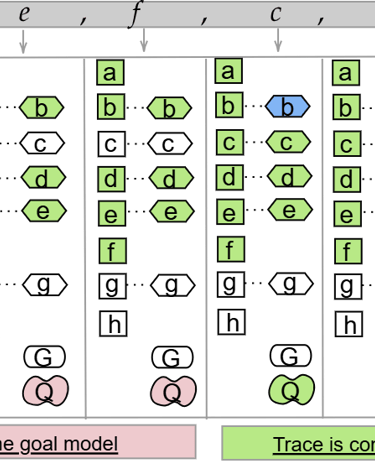
Kogi: A tool for assessing High-Level Business Process Compliance
Caballero Villalobos, J., & López, H. A. (Accepted/In press). Kogi: A tool for assessing High-Level Business Process Compliance. In Proceedings of the Best BPM Dissertation Award, Doctoral Consortium, and Demonstrations & Resources Forum co-located with 23rd International Conference on Business Process Management (BPM 2025)
Abstract: The goal of a business process is to orchestrate activities that achieve a specific business objective. However, most process simulation tools do not assess how activities influence the satisfaction of business goals. Kogi addresses this limitation by aligning imperative and declarative process models with goal models to evaluate compliance with high-level and non-functional requirements. Unlike existing tools, Kogi traces how process executions affect goal satisfaction in both runtime and design-time scenarios. The tool focuses on monitoring the fulfillment of organizational objectives rather than procedural correctness alone. This support shows potential to improve traceability and interpretability of compliance outcomes and enhance communication across stakeholders involved in the business process lifecycle.

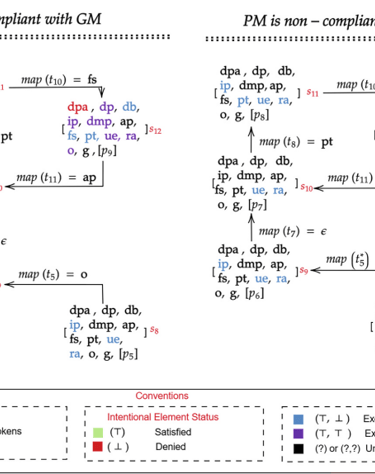
High-Level Requirements-Driven Business Process Compliance
Caballero-Villalobos, J., Burattin, A., López, H.A. (2026). High-Level Requirements-Driven Business Process Compliance. In: Senderovich, A., Cabanillas, C., Vanderfeesten, I., A. Reijers, H. (eds) Business Process Management Forum. BPM 2025. Lecture Notes in Business Information Processing, vol 564. Springer, Cham. https://doi.org/10.1007/978-3-032-02929-4_2
Abstract: Process compliance refers to the alignment between business processes and regulatory requirements. Compliance is difficult because it needs to be able to express the intent and the possible interpretations of laws into formal models, align models with traces in a process, and inspect whether these traces are generating violations. This paper focuses on a largely unexplored area within BPM: the compliance of high-level and non-functional requirements. While compliance checking has been studied through conformance checking techniques, most regulatory requirements are defined in subjective and high-level terms, limiting the application of rule-checking and alignments to specific cases. In contrast, we propose the application of requirement engineering methods for business process compliance. In particular, we raise the level of abstraction from the compliance of specific patterns to the satisfaction of high-level goals and subjective qualities. We propose a framework that connects process models with goal models, rendering explicit alternatives for the satisfaction of vague goals and subjective qualities. Compliance checking is reduced to a reachability of a state where subjective qualities are satisfied. This approach is exhibited in a data protection scenario, and we provide a prototypical implementation of the compliance checking tool.
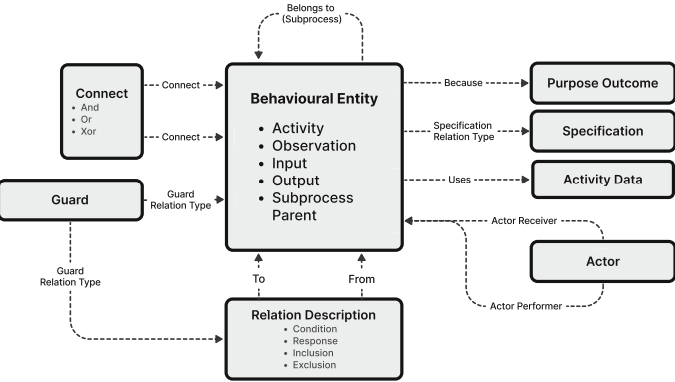

Automating Pathway Extraction from Clinical Guidelines: A Conceptual Model, Datasets and Initial Experiments
Grathwol, D., van der Aa, H., López, H.A. (2025). Automating Pathway Extraction from Clinical Guidelines: A Conceptual Model, Datasets and Initial Experiments. In: Comuzzi, M., Grigori, D., Sellami, M., Zhou, Z. (eds) Cooperative Information Systems. CoopIS 2024. Lecture Notes in Computer Science, vol 15506. Springer, Cham. https://doi.org/10.1007/978-3-031-81375-7_17
Abstract Clinical pathways are structured, multidisciplinary care plans utilized by healthcare providers to standardize the management of specific clinical problems. Designed to bridge the gap between evidence and practice, clinical pathways aim to enhance clinical outcomes and improve efficiency, often reducing hospital stays and lowering healthcare costs. However, maintaining pathways with up-to-date, evidence-based recommendations is complex and time-consuming. It requires the integration of clinical guidelines, algorithmic procedures, and tacit knowledge from various institutions. A critical aspect of updating clinical pathways involves extracting procedural information from clinical guidelines, which are textual documents that detail medical procedures. This paper explores how Large Language Models (LLMs) can facilitate this extraction to support clinical pathway development and maintenance. Concretely, we present a conceptual model for using LLMs in this extraction task, provide a dataset comprising thousands of clinical guidelines for academic research, and share the results of initial experiments demonstrating the efficacy of LLMs in extracting relevant pathway information from these guidelines.
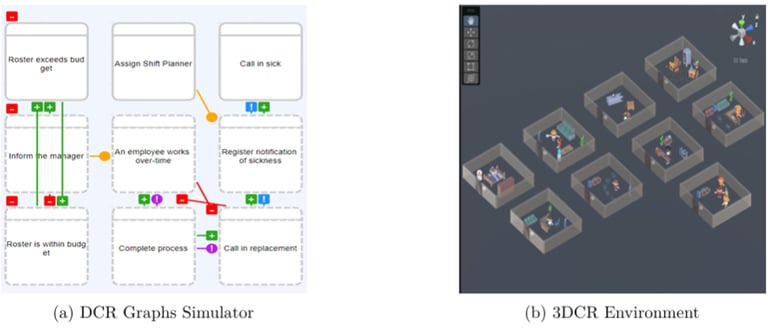

3DCR: A Tool for Immersive Process Mining
Caballero-Villalobos, J., Jensen, S.J., López, H.A., (2024). 3DCR: A Tool for Immersive Process Mining. In International Conference on Process Mining. In Proceedings of the 6th International Conference on Process Mining CEUR-WS.
Abstract: 3DCR is a tool to enhance the comprehension and engagement of declarative process models via 3D gaming environments. Integrating with an industrial declarative process modeling language (DCR graphs), our tool enables a tailored and adaptable environment where novel representations of declarative process elements (e.g., events and causal relations) can be explored, modified, and enriched with domain-specific representations. 3DCR helps in the elicitation of process behaviors, the discovery of processes from user interactions, and the simulation/upskilling of stakeholders in new process variants. Initial usability experiments indicate positive results regarding usefulness, engagement, and learnability compared to 2D process model representations. In this paper, we describe the architecture, functionality, and maturity of 3DCR.


DCR4Py: A PM4Py Library Extension for Declarative Process Mining in Python
Hermansen, S.V.H., Jónsson, R., Kjeldsen, J.L., Slaats, T., Cosma, V. P., López, H.A., (2024). DCR4Py: A PM4Py Library Extension for Declarative Process Mining in Python. In Proceedings of the 6th International Conference on Process Mining CEUR-WS.
Abstract: DCR4Py is the first open-source library to offer a broad range of features and up-to-date algorithms for Dynamic Condition Response Graphs. It extends the popular PM4Py library with a new declarative language and matches PM4Py’s GPL3 license, design, installation steps, maturity, and performance. Our key contribution consists of an open-source implementation in Python of all existing discovery and conformance-checking algorithms for DCR graphs, as well as import and export capabilities, visualization, and conversion, all in a single, well-documented, open-access, easy-to-use library that closely follows the research literature definitions and nomenclature
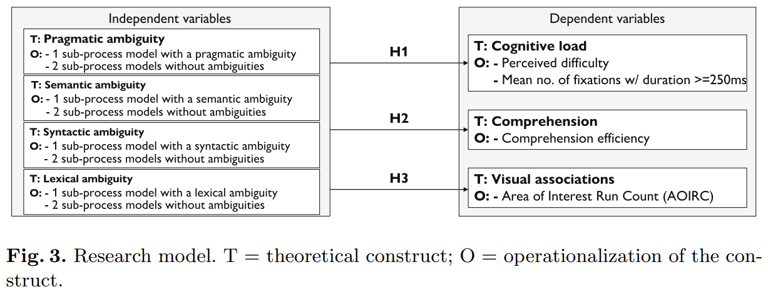

Exploring the Cognitive Effects of Ambiguity in Process Models
Franceschetti, M., Abbad-Andaloussi, A., Schreiber, C., López, H.A., Weber, B. (2024). Exploring the Cognitive Effects of Ambiguity in Process Models. In: Business Process Management. BPM 2024. Lecture Notes in Computer Science, vol 14940. Springer, Cham. https://doi.org/10.1007/978-3-031-70396-6_28
Abstract: Ambiguity in business process models might lead to multiple alternative process interpretations by the readers. This plurality of interpretations causes undesirable situations such as misunderstandings, unclear responsibilities, and unexpected behaviors. However, to date, little attention has been given to how ambiguity affects the model readers. Here, we report on an eye-tracking study aimed at investigating the impact of different ambiguities (i.e., pragmatic, semantic, syntactic, and lexical) on readers’ cognitive load, comprehension, and visual associations when reading process models. The results of this study show that these ambiguities yield a significant impact on cognitive load, comprehension, and visual associations. These results raise further attention toward the negative effects of ambiguity from a cognitive and behavioral perspective, and stimulate the development of novel tools supporting ambiguity detection in process models.

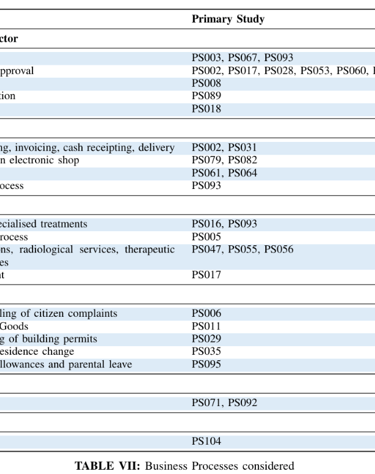
Three Decades of Formal Methods in Business Process Compliance: A Systematic Literature Review.
Hugo A. López, Thomas T. Hildebrandt. Three Decades of Formal Methods in Business Process Compliance: A Systematic Literature Review. https://arxiv.org/abs/2410.1090
Abstract: Digitalization efforts often face a key challenge: business processes must not only be efficient in achieving their goals but also adhere to legal regulations. Business process compliance refers to aligning processes with these regulations. Numerous frameworks have been developed to address this, with the earliest dating back to 1981. This study focuses on rigorous frameworks using formal methods to verify or ensure compliance. We conducted a systematic literature review (SLR) on process compliance frameworks based on formal models. Our goal was to assess the current state of research on process model compliance and identify gaps and opportunities for future work. Starting with 5018 candidate studies from 1981 to the establishment of GDPR, we selected 46 primary studies. These frameworks were categorized by their phases, the languages used for processes and compliance, and their reasoning techniques. We also examined their practical applicability, the case studies they were tested on, the types of users involved, and the skills needed for compliance. Also, we assessed the maturity of each framework. Our findings reveal strong consensus around verification techniques as central to process compliance, though there is less agreement on the earlier and later phases of compliance. Model checking is the dominant technique, but the compliance and process languages have evolved. Most frameworks are still conceptual with prototype implementations, often failing to account for compliance professionals like legal experts or law changes. In conclusion, there is a need for comprehensive empirical studies to better understand the anatomy and maturity of regulatory compliance frameworks, and for robust evaluation methods to benchmark these frameworks. This review offers valuable insights for researchers and practitioners in process compliance.
Danish Center of Digital Compliance
This work is supported by the research grant ''Center for Digital CompliancE (DICE)'' (VIL57420) from VILLUM FOUNDATION.
Contact us
Verify
hulo@dtu.dk
© 2025. All rights reserved.

